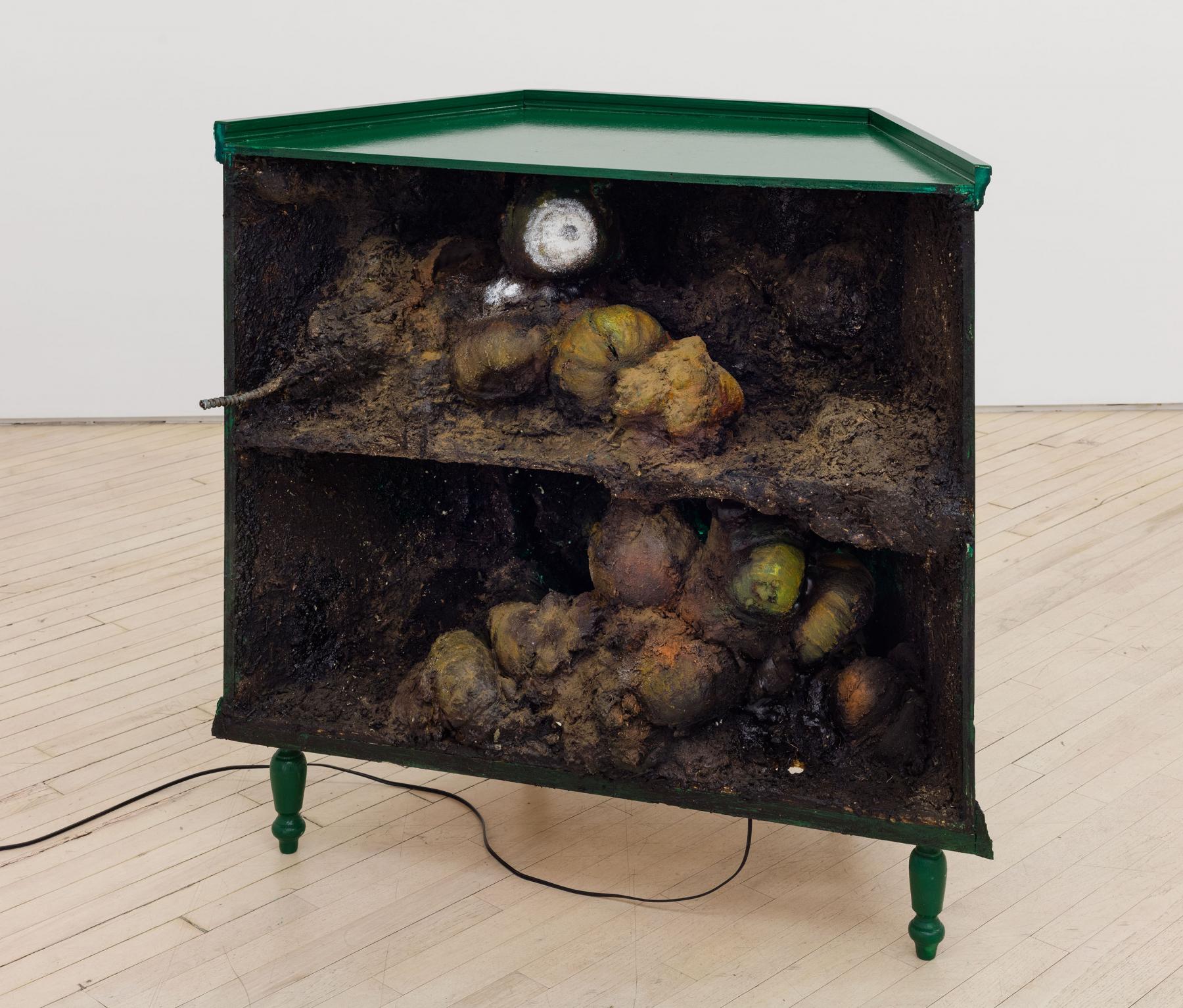
Breeding Ground, 2020 Birch, cast foam, earth pigment, Aqua Resin, resin, enamel, conduit cable, lightbulb, electric wiring 39 × 40 × 21 in.Caption
When speaking with Ndife, he attributes the gunk build-up on the food groups that he references in his work to the kind of poisonous xenophobic lens that they are viewed through. For many Westerners, if a food group has an unfamiliar colour, smell, or texture, it is seen as other, unworthy of tasting. This is especially true for those foods that aren’t as stripped of the cultural indexes they originate from. The food only becomes desirable when it is watered-down, and there’s a consensus to elevate it to a status of the trendy “new” food craze at the local progressive hipster joint. Gober, like Ndife, goes back in time to the domesticity of the home as a child, a site for learning and developing a sense of self in relation to the rest of the world. It is also a site where these prejudices slowly invade our psyche and tint the way we see others, and how they are different from us. This intolerance swells, teeming with a network of polluted fungus. What to many is a natural occurrence and culturally integral is seen as abject to others and something to be eradicated.
In 1857, as a function of the British imperial administration’s colonial rule over Indigenous communities here on the lands now known as “Canada”, the majorly fucked up treaty, Gradual Civilization Act, was passed. This bill set things into gear, and among the many atrocious happenings that the Canadian government got away with, including the Residential school system, Indigenous food sovereignty was decimated. Potlatch ceremonies, traditional sustenance hunting, and gathering practices were all banned under the act. Further treaties were put in place due to strikes and resistance. All in an effort to purge Indigenous identity, assimilate, and contribute to the formation of the Canadian nation-state. As industrialization and scientific advancements (like the stove and refrigerator) began to dominate and streamline the preparation and consumption of food, Indigenous peoples had fewer and fewer choices left when it came to sustaining their cultural traditions.
Getting to spend time closely with Ndife’s work over the last several months, I started to appreciate how much he gives us to think and write about. Through his carefully considered suppositions, Ndife’s forms reach beyond his own interpretation of experience and community, and find more intersections across time/place, as well as broader solidarity.
As I am writing this piece, musician Bryan Adams threw a tantrum on social media about his cancelled shows as a result of the pandemic. He blamed the “bat eating, wet market animal selling virus making greedy bastards” for putting his tour on hold. The racist tirade he posted has since been taken down, but the damage continues to linger. It is just one of several instances in the last few weeks since the emergence of Covid-19 pandemic where anti-Asian sentiments have been rising among the public. It’s this interjection that Ndife susses out in his own work, as he opens it up to find discursive communal ties past his own.
The conversation that follows was patched together through fragments accumulated between Ndife and I via phone calls, emails, and text messages. Our correspondence took place on and off—starting just before last Christmas, and continuing until mid-April. Perhaps it might be useful to keep that in mind as you take it all in. Ndife is a generous conversation partner and as you’ll see, he shares abundantly about the arc of his work so far and where it is possibly headed.
I became interested in how food came to being colonized, how we came to see certain things as native to one place and not another. So that sublimation across borders was again, an analog to bodies. It became how I think about it now: like analogs between who are those here on purpose, and who those are here on lease, or even who’s allowed to be here
What have you been curious about lately?
I have been in the studio thinking a lot about “time” in my works. Implied time. Time as in the way that you can apply it to a setting or something. I’ve just finished my master’s and a lot of the conversations that were happening around my thesis work were about specific memories—or conjuring memories for the viewer.
Interesting.
Some words that came up in conversations centred around trying to placate the work in some past, present, or future; or leaking in between crevices of the three. Especially pertaining to material approach, I think that when people find out that I make a lot of these objects by hand, and treat them with makeup almost in a [special effects] way, it kind of confuses and surprises them. For example, when they find out that I’m not really plucking these things from anywhere specifically. This has followed me in the past six or seven years since I’ve started this work. I think now, I’m trying to think about time in an even more concentrated, speculative, and studied way. Whether that means actually going out to find specific materials or objects that can either be juxtaposed and complemented with that notion of “found and fabricated,” objects that are personally mine, or someone else’s…whether it’s one person, or a group of people.
I’ve [also] been infinitely curious about how different objects or different experiences can be talked about, without reaching a consensus. I like the ambiguity. I like a bit of a smoke screen. I don’t think there should be agreement on what “this” or “that” is, or to go: “I’m not really sure what that was about.” I think that shuts conversations down—and leads to stereotypes, generalizations, and assumptions.
What does?
I think, in some ways, information. In this age we’re inundated with, we think, “Oh that’s curious, I’ll just type in keywords and I could become an overnight scholar on somebody or something without actually engaging with it at all.” You can get the gist of someone just by typing keywords about them into the Internet or looking up a couple of videos, and being hip enough to not engage—but be an interloper, a bystander. That’s kind of what I was thinking as far as this way of being an in-between, weird hybrid of yes and no, this speculative place, this “maybe” place.
Would you consider your sculptures as being anonymous? I ask because you mention time being inconclusive in certain ways, and so it becomes hard to place these objects in any particular way. Do you think they are cut off from something else that perhaps—identifies?
Right, I always think of my sculptures as not belonging to anyone or any place specifically. I always think that I make sculptures that are meant to be jettisoned and unclaimed… almost left behind. A lot of the feelings and embodiments I’ve been [working through] are sculptures that can be described either as discarded and not-needed; or juggled between being a necessity versus something that would be kind of weighing [the owner] down... I’m imagining a scenario where a person in a rush was like, “I can only take so much, and though this is important to me and holds so many memories, it’s just too much stuff for the journey”. So the sculptures are like remnants of someone’s lived-in experiences, but either in the time of crisis, or when a decision was made to leave them behind. So they’re kind of orphaned.
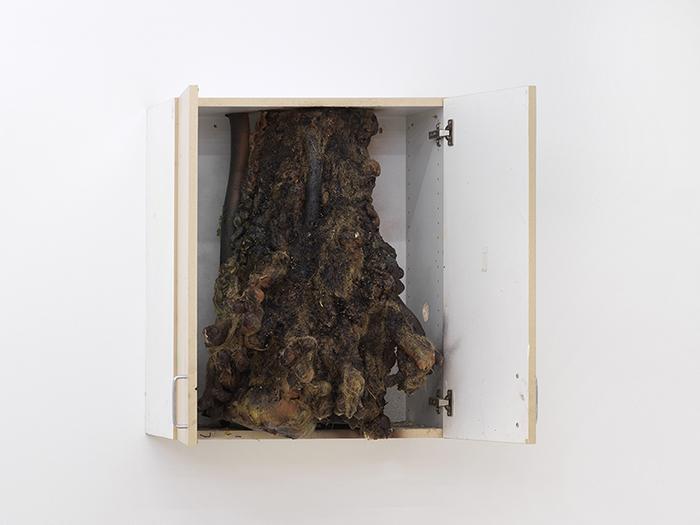

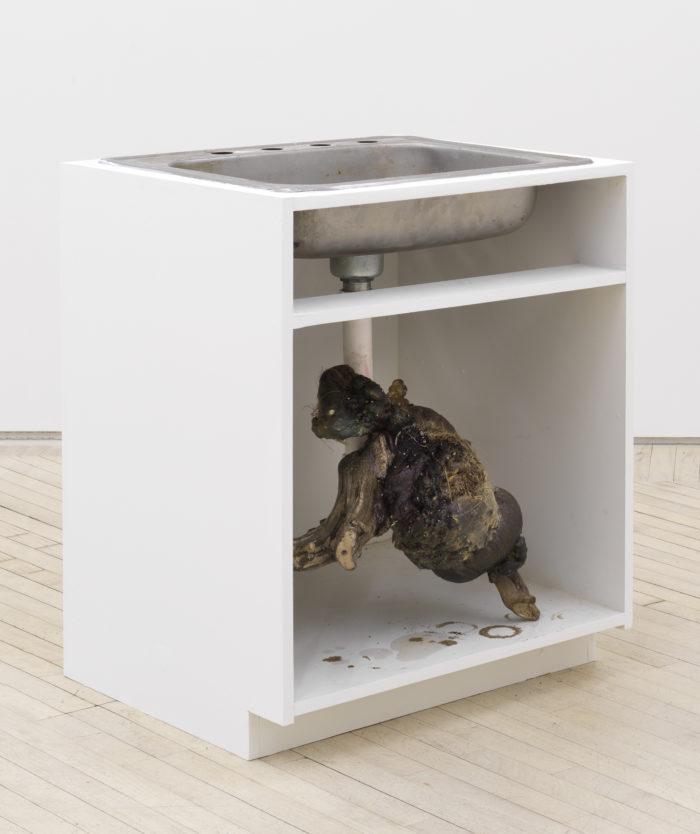
So the sculptures are inflected with a body, but it’s not particular to any kind of body?
I would say that rather than a specific body, it's more connected to a community. Particularly an inner city community.
Their materiality speaks about a cheapness, or something that is the bare minimum of value. I think a lot about housing units and about estate houses that have these rudimentary, basic, readily-available, and very generic design qualities about them.There’s nothing to them except what the inhabitant imbues in them. What completes them as objects is the disembodied person that used to live with them, the completeness is the disembodied person that used to live with that thing: so when they’re severed, that kind of relationship is gone.
They turn back into empty vessels and these kinds of vegetations then become, for me, those bodies; inhabitants again. It’s no longer flesh, bone, blood—but indexes that are specific to a place. That juxtaposition, for me, is filling that kind of relationship.
You mention these objects in a way, “transitioning” from being separated from a prior history and becoming a blank form, but then transitioning back… So how does that transition happen, like, going back to relating to a body?
Oh, yeah. I think this study observation became about my experiences in the Western world, of having to bring yourself into a new home. I feel that the best way to enter this (re)lation to form, or to context, is by using International markets in small towns as a metaphor. Like, you can denote where a certain demographic is relative to from the import store it is nearest to. It becomes this watering hole of sorts: there’s the Asian market, there’s the African market…You can place a group of people by their proximity to that, like, when groups of people arrive in the West, they congregate towards those places. There’s an anonymous gathering within a place of ostracization. So, for me, it was taking this understanding and thinking about a lot of fictive writing; science fiction and things like that, to create a set of foils within my sculptures.
Then, answering whether or not the furniture is void of an actual person or people became about, like, what’s stocked in that kitchen. These vegetables—these yams, these bitter gourds represent those people—you know what I’m saying? It’s sort of what would be in this home, what would be in this place, like, under its footing. I’m trying to isolate those details in a fictive way. What would those two interactions blend into? What would be around when the people are gone, or when those inhabitants and citizens are gone? I’m thinking it would be this kind of man-made, natural blend of these two organisms: one organic, one inorganic, and where they would meet. They meet somewhere in my sculptures.
...the materials I use are pretty specific to non-Western contexts. I think a lot about these vegetations being specifically African over-growths—the yams, gourds, food stuffs—that come from a population that’s already seen through a xenophobic lens, or in a foreign or very much racist context, and would be seen as intrusive entities. So I kind of take that fear, that sentiment, and I turn that into the filth of the sculptures.
There seems to be a latent biographical link to your interest in state housing and types of furniture or possessions associated there which you seem to be returning to. But it also appears that you might not want it to be read into your work—and you can correct me if I’m wrong. I’m curious as to why there’s a focus on these specific materials, vegetations, and scenarios you’re after? Also, do you think that there should be a biographical distance to your work?
It’s like I mentioned before, my work definitely comes from my surroundings, within which I’m part of a group—as a family, a nationality—but the aim is less to center the work around biography. I wouldn’t say my practice is about my family. A big caveat of labeling specific to food is that globally, it has permeated most borders and context, even down to seasonal availability. My mind does not think of the work belonging to anyone, or place specifically. Part of these scenarios and materials are more of a reality to those closest to me. I’m constantly thinking of those whose lives are similar but quite different than mine. Honestly, there is quite a distance to these specific materials I use (Cassava, yam, gourds, etc.) and their associations to “me” and my everyday. I am maybe reverberating to a familial tie to these objects. It’s complicated.
The works you had as part of the two-person exhibition—Minor Twin Worlds—at Bureau in New York was a bit of a departure from previous works. At least in a formal way. Would you say it’s all in the same train of thought?
I had always been using contorted, weathered, found objects. I think that the work started during my undergrad, in 2013. New York had a pretty historic hurricane, [Sandy], in 2012 and I began combining and slightly altering these jettisoned artifacts. But from then on, I think it was only 2017, when I started to actually create my recent works. I think the focus became a little tighter around then, towards this dichotomy that I’ve been talking about: setting it up a little bit more. But I have always been making slight alterations to copies of real things.
So, to an extent, it is one continuous inquiry.
It’s weird because I have always thought that my work follows a certain pathos and isn’t working so much in an ethereal way. The work kind of splinters off into a series of meditations of smaller instances that were in other sculptures, but I think it’s less of a series and more of a meandering after an intense study of one thing that has many different forms in it. It’s not like a straight line for me—the way I think about what is coming next.
To go back a bit, you mentioned people are often surprised by the objects being fabricated. Can you speak more on that?
There is a lot of surprise. Some think the work is completely all found, including the vegetation bits. But I am imagining the sculptures as propositions or stories or other kinds of things that go beyond just the found element. Some people make connections quicker; the different scale shifts might be a little subtle or kind of uncanny. “This cabinet is a little taller, or a little shorter than a run-of-the-mill one…” Others can pick up that I’m making these things from scratch and the referent is the space where they become propositional. I think to that end, the question I’m thinking about is: “how can I sublimate the treatments or the efforts behind aging something or bringing in different timelines, to the objects that I make?”
That speaks to a kind of artifice: making things appear a certain way for different purposes. You mentioned makeup and effects, and so I’m interested in how you’re moving the objects you make into a specific realm where it’s in this believable space of being something that presents itself in a particular way. If you can speak about that kind of artifice and the surfaces that you’re presenting to us, [the sculptures] look like something that we might be familiar with, but they’re completely fabricated.
For me, I think a lot of the effect space comes from wanting the audience (and for me as well, in the studio) to just go head-first into a literal space where maybe we can talk about, for example, insolubility of certain materials, or think about where certain materials propagate in trash: it’s a way to tell a story about where people live with excess of things. I think it’s a snapshot into something that says: “This is where we are at with our stuff.”
A separate thought from that is, sometimes, I end up using the makeup or stage [the object] or construct it from scratch because [some of these objects I see out there] can’t even physically be dragged into a studio or a gallery context. And so I have to meet it with some kind of integrity and translate it from memory or from a kind of dedicated mimicry. For me, it also brings about a kind of lightness to the work, like, “this thing is so overrun with overgrowth” but in all senses it’s actually been treated with a lot of care, and for me, it’s also just an appreciation of its beauty. To make [the object] look this way, there are so many treatments that border on a fetishization of it, but I think it’s also just that I want clarity about what’s presented, so a lot of times I’m just going to start making it.
...I think just being black, we living in a science fiction movie everyday—and speaking just for me—but also any kind of minority group, there is a kind of underbelly of ways of communicating that pass around everyday and that are just methods of survival and acknowledgement.
You also mentioned science fiction and I wonder how much that plays into it too, in terms of it being this kind of other space that is parallel to it;either an understated or overstated space for contemplation on a specific material engagement that you wouldn’t be able to access in a very ‘real’ space. How do you think that also feeds into how you’re thinking about creating these objects?
I think more about the fiction part more than the science. I think about the sort of placement that I’m allowed to be in, somewhere pretty close to reality but in a certain future or in a certain, suspended time-space. I kind of like to be thinking about science fiction in the back of my head just by way of thinking about actual science and making sense of these figures that get thrown about on the news in a very heightened sense of panic. There’s a little bit of claustrophobia to where we are now. And the materials I use are pretty specific to non-Western contexts. I think a lot about these vegetations being specifically African over-growths—the yams, gourds, food stuffs—that come from a population that’s already seen through a xenophobic lens, or in a foreign or very much racist context, and would be seen as intrusive entities. So I kind of take that fear, that sentiment, and I turn that into the filth of the sculptures.
I’m looking at science fiction by way of Invasion of the Body Snatchers (1956), but also thinking a lot about poisonous racism, or poisonous xenophobia. Or just overall a lack of understanding of things, a lack of boundaries of the things, so I’m thinking of the gross taking over these prefab furniture—these Ikea-like modern things, modern standards of ready-made accessible design, status quo things—and implanting them with what I know, or what a certain population knows about these vegetables or food stuffs. There’s a mis-recognition that I play into too. There’s almost an invisible calling to people who do know what these things are. I don’t know if that frustrates people, or if that’s just me being a bit cheeky about things, but I think that’s important too, that some people do know and some people don’t…I think just being black, we living in a science fiction movie everyday—and speaking just for me—but also any kind of minority group, there is a kind of underbelly of ways of communicating that pass around everyday and that are just methods of survival and acknowledgement. So, that’s a lot of where I put the context of what I use into the work. I’ve had a lot of comments [about the work] and it being written off as being just gross, rather than being something like sustenance. I think those kinds of distinctions are interesting to me. I’m still learning a lot about what to do with that.
Yeah, a lot of things popped into my head while you were talking. When you mentioned actual science, what came to my mind was it being very much an objective field and whatever information delivered into it seems to be totalising and exacting, so it’s interesting to see how you’re playing with that—I think in some sense, adding more subjectivity. Destabilising that totalising way of looking at something.
Yeah.
You also mentioned communicating something when only a few people know what you’re talking about, or that what you’re communicating is maybe only meant for a specific eye and I find that interesting. I wonder if that’s a way of protecting, or a way of distancing the viewer as a means of protecting some accessible legibility.
Right, it’s interesting because that protecting that you speak about, there’s a certain opacity to figuring out where the audience places themselves: on the side of the cabinet or on the side of the growth. And then I think, there are two kinds of disparate entities becoming one. I think that the same can be said for the viewership: it’s fruitless to say no one has been curved or touched by the Western world no matter where we’re coming from, what we read, what we study, what we aspire to even do out in the real world. So much about that is a funny doubling of critique but also falling in line with what we’re critiquing in a way. For me, it’s juggling dual consciousness to embrace the work as something I know, some people won’t get this, but there’s a layer of objectivity… a botanist from wherever, Europe, would be able to recognize this genus of plant and where it comes from, you know what I mean? So it’s this interesting, hopeful barrier but I think it’s also something that could hinder in a way. Not damage—but maybe be overprotective—and then what to do with that kind of dual impulse, or reflex? Saying that this is “of me” and I’m presenting this to the world, but do I want to be understood by the overarching institution or this kind of overarching hegemony? For that reason, I’ve also never tried to make it legible on one side or the other. I think it’s just kind of jumbled in there.
Right. But I think it’s an interesting conundrum of how much access to give for the purpose of being “understood,” and how much to hold back for the sake of your own protection. I think both of them are useful and offer a sense of agency. I think there’s a lot of freedom within the space of not being able to be pinned down easily. That’s part of the reason why I asked about your sculptures being anonymous and to me that means not being able to be identified, and I think that was part of my first impression when I saw your work: this not knowing where to place it exactly. I think that’s a useful thing although there are a lot of ties, you can make ties to things that you’ve seen before, but it still has this kind of separation from specificity. But then you mentioned how much it ties to a community and so that the objects aren’t entirely, autonomous.
I’m interested in the analog in between, maybe in my sculptures they’re pretty hard to separate and identify. I think they’re autonomous but what brings them together, as far as thinking like a community, is thinking about these things literally being under our feet, or thinking of these things being approached by a double take, or a kind of appendage that we leave off behind or when we move.
I’m working on a grant right now and thinking about making a set of sculptures that are just these “left behind” items of furniture and things that are not seized but just jettisoned. There’s always going to be some scar tissue or half-life of things, and I think that those things are analog to how history works.
As a collective—black artists, black writers—we kind of fall into a lineage of following a discourse that is a palimpsest of what was before… We don’t have the advantage of completely separating our viewpoint from just being citizens of the world. I think we have a lot to work through, and I think our work is, for me, already in a community space; but again, to whom?
I can’t say if the universal forms that I use are speaking to a sort of community because these are kind of rudimentary things, but I do think a lot about urban housing, public housing, and the quality of these things. In certain contexts, people treat these things as if it’s fine china, even if it’s like, the armoire.
I think a lot about heirlooms too, inherited goods that are used over generations… That’s an analog to thinking about in a community sense, an overarching narrative that is splintered off into the millions of specific lives that we live.



Why is it sculpture for you? It seems to lend a lot of itself to drawing. Why make it physical through sculpture?
The processes I go through, although they finish as a physical sculpture, include periods where I’m just painting everything, or periods where I’m just actually drawing each cut. For me, I’m drawing in real time. It’s funny you bring up drawing because I often make the drawings for these sculptures before I even start, and I haven’t really shown them, but maybe it will be a good time soon. A question comes up a lot: “what about thinking in 3D does it for me?” And really, I embed a lot of these feelings into something that is kind of blank. Every component; from the screws, to the rubber, to the foam, to the paint that goes on and the kinds of treatments, all make a historical document to reckon. For me, it’s like I’m from Bones [TV series] or something, pulling these things up from the ground and building them again. I approach them like a ruin, or a historical document. And then I also think, that’s kind of how I would like the rest of the world to have that same kind of appreciation or awe around the black experience, you know? Treating things that like… I just think about going to museums a lot and how everything could be looked at in the future if it’s like, “these were the pews in South Carolina when Dylann Roof shot the church” or like, loaded historical, traumatic, important, first-hand documents. I think a lot about my sculptures in that way. How about we talk about this like a kind of consecrated, sacred thing, you know?
I also think about a lot of African art and Asian art, where anthropologically we speak about them as votive sculptures, but these are literally analogs to people: these are people sitting in a house right now. I think for me, it’s about approaching that thing with my body. I need to be either ten feet back from it, or something that I can get up close to and even smell it, something in the round, something about being. I want other people to think about this thing as taking up space right next to me, what do I… am I repulsed or should I even be, if I stand here long enough, will I feel more comfortable with this thing, or..?
You mentioned in another conversation about attributing a kind of journalistic approach to how you were composing these, as a way of documenting and witnessing, and that seems to me very much, verbatim. It’s taking or absorbing something and then regurgitating. But the way you’ve been talking about it now, it seems more saturated with… for lack of better word, memory. So, it becomes very much messier than just mere documentation or journalism.
Yeah, it’s many of those things. I think the initial read on them for me is to go into the studio with that kind of intensity of consecrating this thing as really important or really sacred, as you were just saying—in a memory space, almost dedicating it to someone. But I think a lot of what I meant before is that it is about the approach to detail maybe, or the approach to the kind of, I guess “openness”? A lot of those forms don’t really try to hide anywhere. For me, I think they definitely present themselves clearly out in the open, so I guess in a lot of the way I think about the journalistic or kind of eye-witnessing space as if no one has really tried to blot its intensity or tried to hide any part of this freakish instance.
I’m still kind of playing and pulling with what is revealed and not, and what could be implied. ; these different speeds of approaching, I guess. I think a lot of the work before has just been very wounded I guess: a bit starker, a bit more of an emergency. What I’m thinking about now are slower memory movements, where you can kind of peel back and actually bring in more unilateral associations. Before, I think I was a bit jaded, tired, a black dude out here who didn’t really care if a lot of people didn’t get it. Now the conversation includes not just our community, I think we’re all kind of twisted up in this thing together. I think our experiences are actually more common than we think. And that’s kind of my thinking behind things now. I’m interested in how to be nuanced and pointed, but definitely have more segues for people to approach and think about their own memories.
When did looking specifically for, or starting out with vegetation stick out to you?
I started this work between 2016 and 2017. I was thinking about where I was living around that time. I was living in a neighbourhood that was what you’d call a food desert or something. So I was thinking a lot about access, and reading a lot of diasporic writers at that time. I became interested in how food came to being colonized, how we came to see certain things as native to one place and not another. So that sublimation across borders was again, an analog to bodies. It became how I think about it now: like analogs between who are those here on purpose, and who those are here on lease, or even who’s allowed to be here. I think that’s where the vegetation kind of came in.
This might be similar to a question I previously asked but I think it worth asking anyways. I've been thinking about aesthetics in relation to your work. You show us bits of wreckage, rotten, fermented forms, etc but I don't know if it is because they are fictionalized and/or in the context of a gallery display, but they become these objects of aesthetics to some extent… What do you think about these forms being seen that way? And also, since you are partially fabricating these, how close do you get to wanting to get to what you are referencing? Is it important that you get a close depiction? Or lean towards an approximation?
It’s a big task for me to tackle the weight that aesthetics carry in speaking about art. My only honest attempt is that in my work, it’s a way for me to describe something outside of myself—I guess using specific formal cues is the way I use storytelling. Everything has its aesthetic terms. Would any of what I am interested in come across if I excluded these forms you mentioned? I don’t know. But, maybe it wouldn’t be my practice. I think in my terms, approximation can be a placeholder for words like “imagination”, “inspiration”, “motivation” to some end. The approach to the hyperrealistic or perfectly rendered is a line I like to get close to, but not necessary to fall into.

Installation views from MY ZONE: Hygge, 2020, Plywood, cast foam, earth pigment, AquaResin, resin, enamel, ceramic plates, 38 ½ × 25 × 21 in.
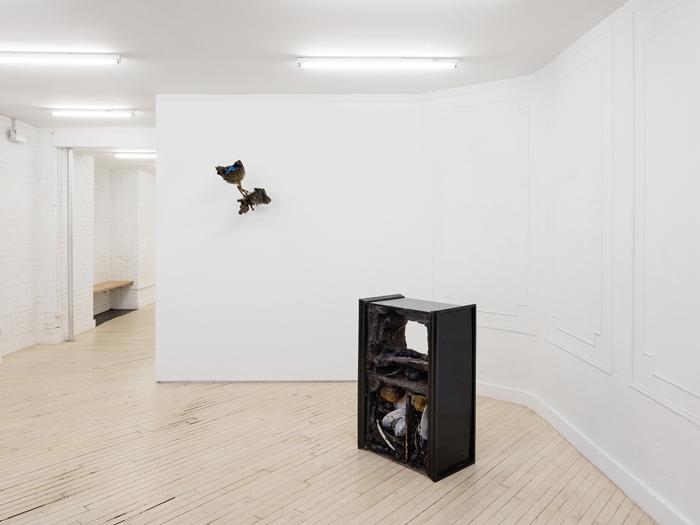

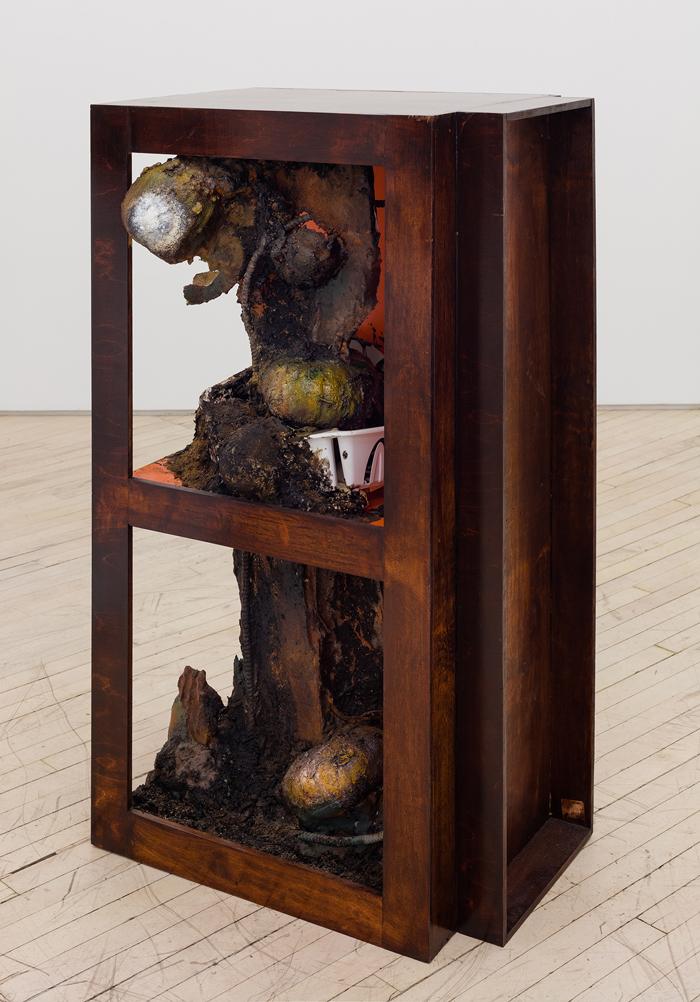
Modern Dilemma, 2020 Birch, cast foam, earth pigment, AquaResin, resin, enamel, conduit cable, dish rack, ceramic plates48 × 27 ½ × 21 ½ in
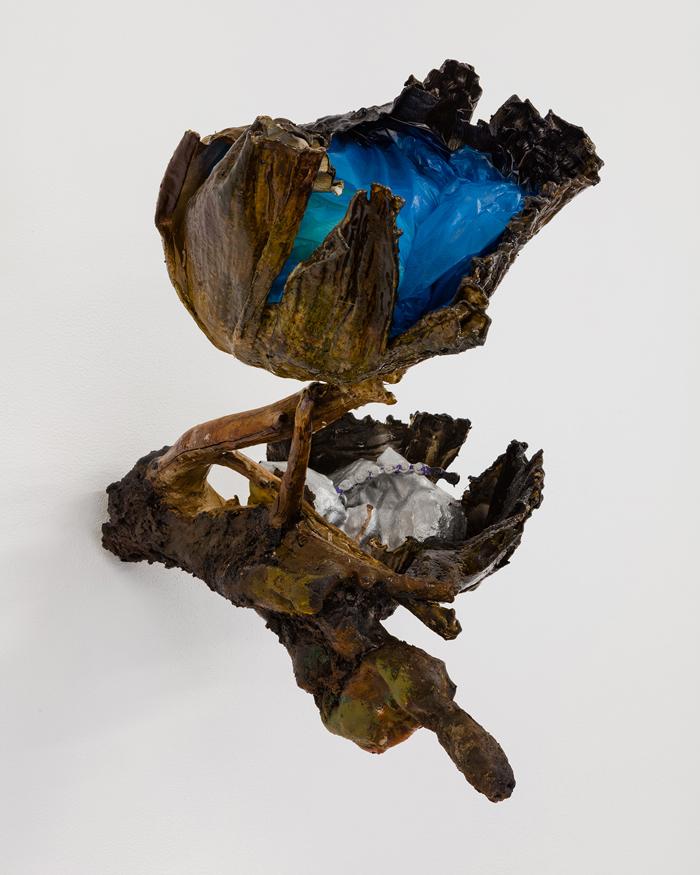
Installation views from MY ZONE at Bureau : Sconce, 2020 Corn husk, resin, AquaResin, earth pigment, enamel, wood, aluminum 17 × 17 × 20 in.
As we speak, your current exhibition MY ZONE is currently on at Bureau so thought I'll include a question specifically about it: the title immediately announces itself as a personal/private space but through our conversations, you stem the work from something broader than that. Can you elaborate on the choice of that title?
I was thinking about how the title could be seen as an identification of the setting for the show—the furniture exists in a fictional arrangement of sorts, like in an abandoned apartment. MY ZONE came about in collaboration with the author of the text accompanying the exhibition, Charlie Markbreiter. We wanted to think of the text he eventually wrote as narrating the show at large—a fictional speaker living alongside these objects and how the accumulation of such mess stems from an unidentifiable set of circumstances. I wanted the work to have an “owner”, previous or current.
At the end of our last conversation, you briefly mentioned that you might be interested in making work that could live outside the gallery, or be out in the larger public. Can you speak more about this?
Right. I definitely want to foray into working on public work and interactive settings. The aura of sculpture and spirit of encounter is very appealing to me. The contexts of using “signifiers” so that the everyday and recognizable could be made much more stark and arresting, if the usual directives and etiquettes of the white cube were severed. I imagine since I have begun to think of my work as having invisible or implied “inhabitants” around them, I am playing with the idea of blending installation with theatre. A lot of comments and rumination on my work have been about the realm of stage design and set design, not unlike production design in movies and in theatre.
A term that I always keep in the back of my head was the title of an exhibition I saw long ago during my undergrad years, Prosopopoeia. It’s an Ancient Greek figure of speech surrounding Greek theatre, in which an imaginary or absent person is represented as speaking or acting. It’s something that really has directed a lot of the thoughts around my work, and how these avenues of open experimentation, outdoor sculpture, and performance that I’m working with now continue to serve as inspiration for approach.